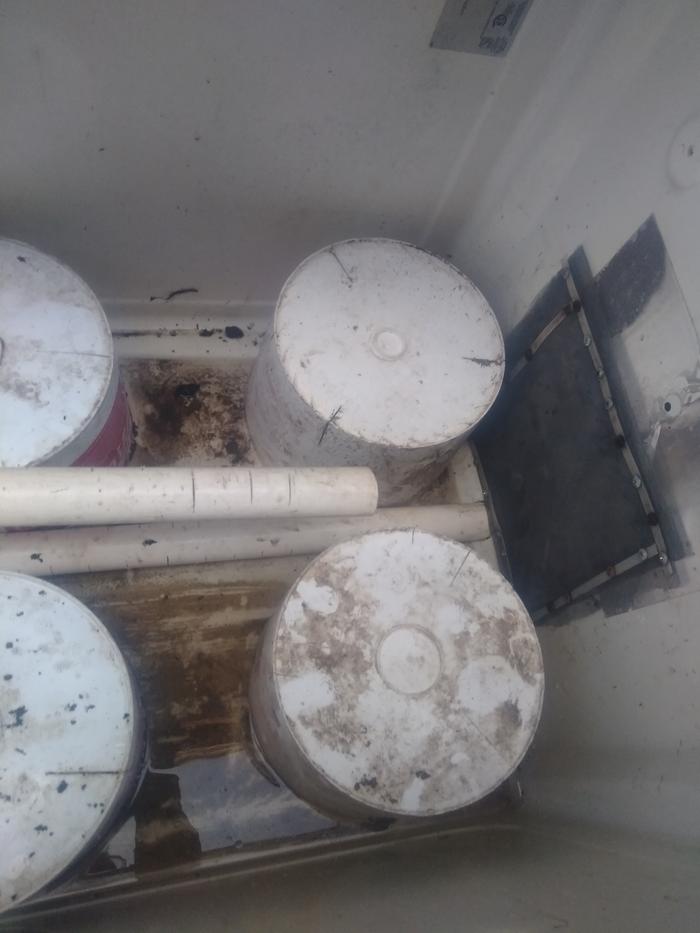I have had no time for physical progress on the worm bin, but that has given me time to reflect.
This was perhaps the first idea I ever brought to permies to share, about 8 years ago, and it still looks mostly the same.
I think I will use only 4 inverted buckets for the reservoir.
This will allow a 1 foot thick layer of material between the reservoir and the freezer compartment.
The freezer compartment will be where I aerate , pump or heat the water, as necessary, and as such it will be separated from the main compartment by mesh.
I hope to spike the bin with King Stropharia spawn and allow it to establish, before moving the worms in.
I'm not seeking a crop of mushrooms, but I do want the
compost to be infused with spores.
I will include a slotted drain pipe down the center of the fridge compartment, and out end of the fridge where the compressor once was.
The other end will penetrate the wall between the fridge and freezer, where it will be capped with a threaded fitting.
The fitting will be there so I can attach a filter, air line adapter, or whatever else I chose.
Higher up in the fridge section, there will be a second slotted drain pipe.
This pipe will be at about 8" high, and act as an over flow.
Where both drain lines leave the compressor end of the bin, a clear vinyl hose will connect the two , and act as a sight glass or water gauge.
The lower drain pipe will have an inline shut off valve before it it again connects with the upper drain pipe, and both connect to a garden hose threaded drain spout.
If the worms and the fungus are processing the incoming waste easily and well, I will add a gold fish to the freezer department.
If it dies , I will add an air pump and try again.
if that one dies, I will just add duck weed, and maybe a light.
If any of them live I will add more till there are 10 at most.
If they breed, I will probably feed the excess to the chooks.
I might already have a light in the freezer compartment, just to add heat to the system.
I would regulate it with a Rainbird or other, even more basic controller.
LED rope lights are tempting because they are ready for wet locations, unfortunately they emit very little heat.
An immersion heater is probably a better choice, and I don't think it will be on very often.
If heating is necessary at all, a heated bucket at the drain end could house a circulating pump.
By circulating the heated water through the system, the pump would allow the heated bucket to water the chickens and heat the worm bin at the same time.
More energy use, and more devices purchased is not a goal.
Perhaps a bucket of warm water could be manually cycled through the system each day.
Would it be safe to water the chickens and dog with?
I let the animals decide what they will drink, and usually they choose funky rain water over fresh tap water, and are none the worse for wear.
I will be moving this further from the house, if I wan the chooks to still be able to feed them selves from it.
My wife has finally tired of poop on the walk way, so I be fencing them into the perimeter of the yard, and out of our way.
This might be very good, as I can raise it up to create more chicken habitat.
They always come out of the coop, even in the worst weather, but a dry spot under a table etc, is very desired.
Fresh chicken poop is said to be too hot for worms, but I am tempted to build an mesh bottom coop right over the worm bin, and see how the worms handle it.
I better test this idea by feeding them fresh chicken poop b fore i go for it.
Maybe If I get another fridge , I could test out a deep bedding bin with hissing cock roaches.
If I include a self serve escape hatch leading to a bucket, my chickens could eat their own janitors!
I Have seen systems like this described for raising meal worms and solider flies but meal worms are kinda particular and despite reports to the contrary solider flies stink like nothing else.
Anyway, office hours are over now, time to do some show work.









 1
1




 1
1






















